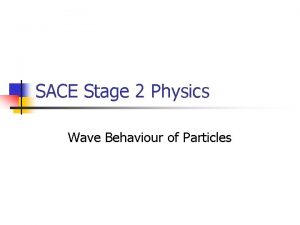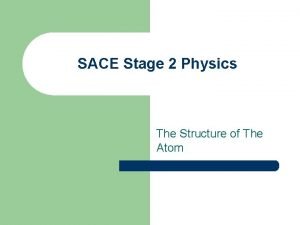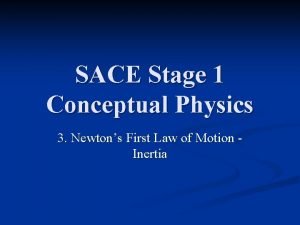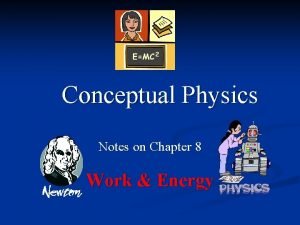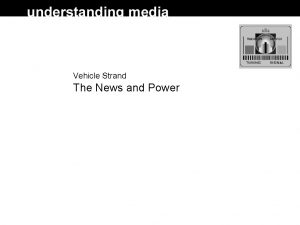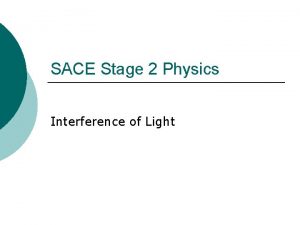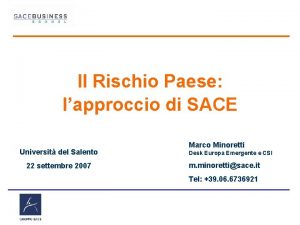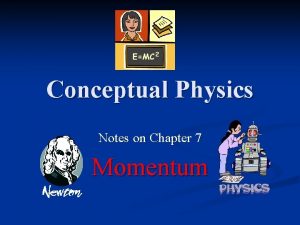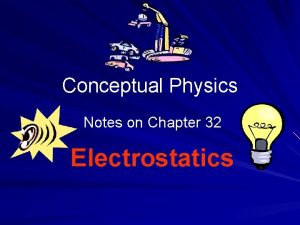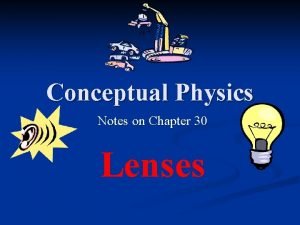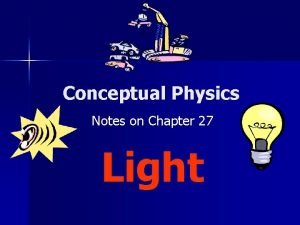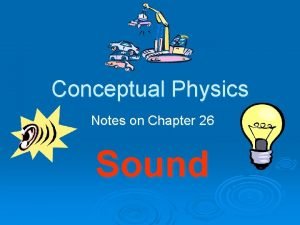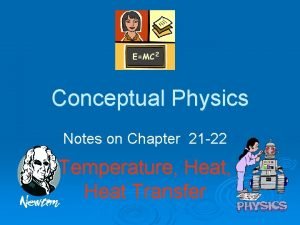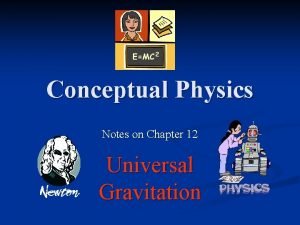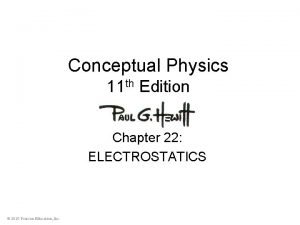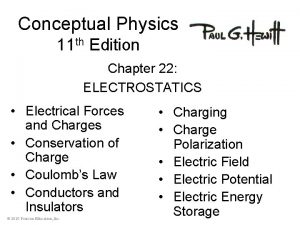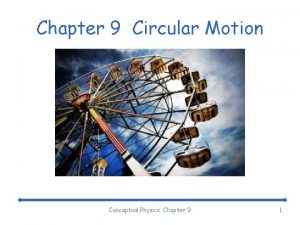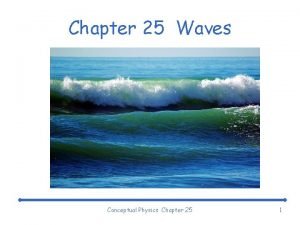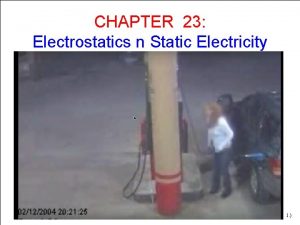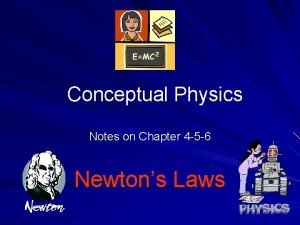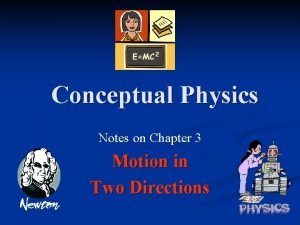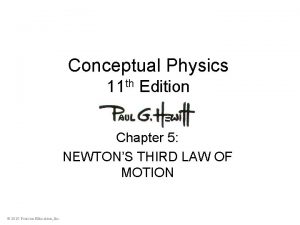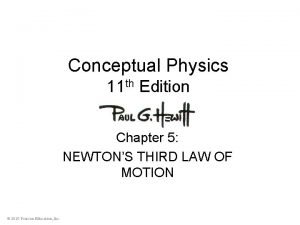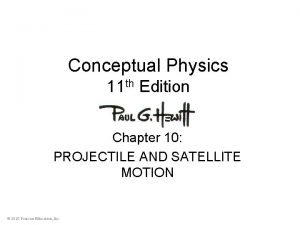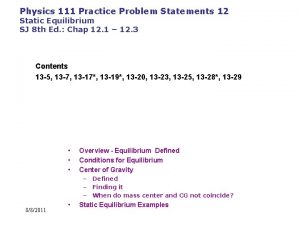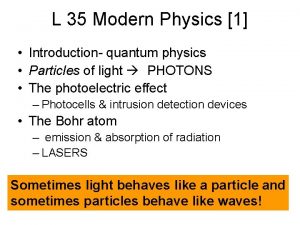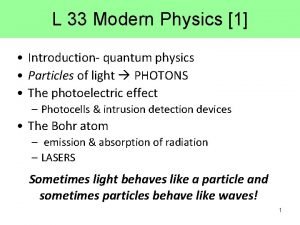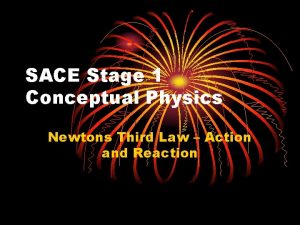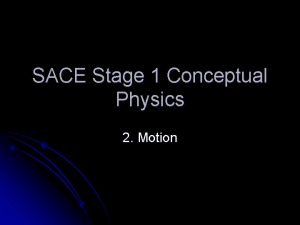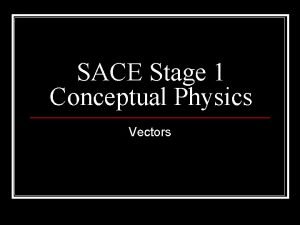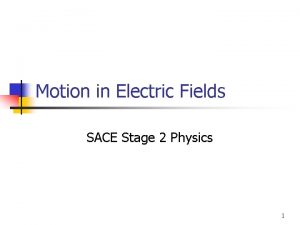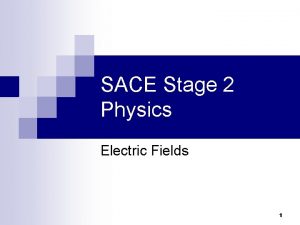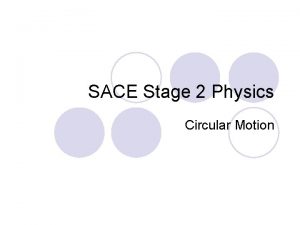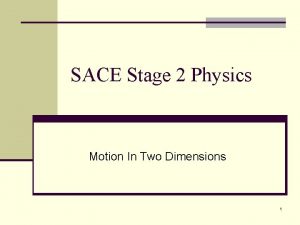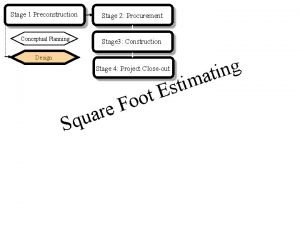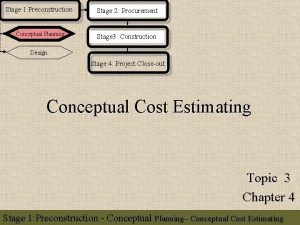SACE Stage 1 Conceptual Physics Energy Introduction Energy




















































- Slides: 52

SACE Stage 1 Conceptual Physics Energy

Introduction Energy underlies all science. n Relatively new concept (1850’s) n Can’t observe energy directly, can only observe energy when it changes from one place to another or one form to another. n

Work n As Impulse is Force x Time, Work = Force x Distance

Work We do work when we lift against the Earth’s gravity. n The heavier the load or the longer we move the load, the more Work is done. n

Work n 2 things occur are involved when ever work is done, n n The application of a force The movement of something by that force

Work n The unit for work is Joules (J).

Work n Example – How much energy is used in lifting a 5 kg mass vertically upwards 2 metres?

Work n Example – How much energy is used in lifting a 5 kg mass vertically upwards 2 metres?

Power Definition of work doesn’t describe how long it takes to do the work. n Why do you feel more tired when you run up the stairs rather than walking? n POWER, the rate at which you do work can help answer this question. n

Power n Power = The rate at which you do work. n The units for power are Joules per Second (J/s) or the Watt (W).

Power A high powered engine does work more rapidly. A car engine with twice the power of another doesn’t necessarily produce twice as much work or go twice as fast as the less powerful engine. n Twice the power means that it will do the same amount of work in half the time. n

Mechanical Energy n Mechanical Energy – the energy due to the position or movement of something. n Animation - Physics Applets/ph 14 e/pendulum. htm

Potential Energy Objects can store energy by virtue of its position. n The energy that is stored and held in readiness is called potential energy (PE). n In the stored state it has the potential for doing work. n

Potential Energy Work is required to lift objects against the Earths gravitational field. The potential energy due to its elevated position is called gravitational potential energy. n The amount of gravitational potential energy in an object is equal to the work done in raising that object against the earths gravitational field. n

Potential Energy n The work done equals the gain in potential energy. n Note that the height, h, is the distance above some reference point. Potential energy is relative to this point.

Potential Energy n All of these rocks contain the same amount of potential energy. The work done in lifting the boulder is the same in each case.

Potential Energy n Q – How much work is done on a 100 N boulder that you carry horizontally across a 10 m room?

Potential Energy Q – How much work is done on a 100 N boulder that you carry horizontally across a 10 m room? n A – No work has been done as the boulder has not changed its vertical position. n

Potential Energy n Q – How much work is done on a 100 N boulder when you lift it 1 m?

Potential Energy n n Q – How much work is done on a 100 N boulder when you lift it 1 m? A–

Potential Energy n n Q – What power is expended if you lift it this distance in 1 s? A-

Potential Energy n n Q – What is its gravitational potential energy in the lifted position? A – Gravitational Potential Energy is equivalent to the work done in getting their, therefore it has 100 J of gravitational potential energy.

Kinetic Energy n The energy of motion is called Kinetic Energy (KE).

Kinetic Energy n When you throw a ball, you do work on it to give it speed when it leaves your hand. The moving ball can then hit something and push it, doing work on what it hits.

Kinetic Energy n The Kinetic Energy on that object is equal to the work done on it to make it move.

Kinetic Energy n n Notice the speed is squared. If the speed of an object is doubled then the kinetic energy is quadrupled.

Kinetic Energy

Conservation of Energy n Too difficult to describe energy in terms of what it is but better describe how it transforms.

Conservation of Energy n Definition – Energy cannot be created or destroyed; it may be transformed from one form into another, but the total amount of energy never changes.

Conservation of Energy n Consider a pendulum, when the “bob” is at its highest, all the energy is in the form of potential energy, when it is moving at its lowest point, all potential energy is now kinetic energy. When the “bob” swings to the other side the energy has turned back into potential energy.

Conservation of Energy

Conservation of Energy n When the lady in distress leaps from the building , note that the sum of her PE and KE remains constant at successive positions ¼, ½, ¾ and all the way down.

Machines A device for multiplying forces or simply changing the direction of forces. n Underlying every machine is the concept of Conservation of Energy. n

Machines Consider one of the simplest machines, the lever. n We do work on one end of the lever and the lever does work on a load at the other end. n

Machines n The lever Work input = Work output (force x distance)input = (force x distance)output

Machines n The output force (80 N) is eight times the input force (10 N), while the output distance (1/8 m) is one eighth the input distance (1 m). ph 14 e/lever. htm

Machines n Three ways of setting up a lever. n Depends on the position of the fulcrum.

Machines A pulley system is a kind of lever that can be used to change the direction of the force. n Pulleys can multiply the force as well. n

Machines n When combined with another pulley, both can change the direction and multiply the force. Input Force x Input distance ph 14 e/pulleysystem. htm = output force x output distance.

Machines n Efficiency can be expressed as the ratio of useful work output to total work input. n An incline plane is a machine. Sliding a load up an incline requires less force than lifting it vertically.

Machines n Pushing the block of ice 5 times farther up the incline then the vertical distance lifted requires a force of only 1/5 its weight. Whether pushed up the plane or simply lifted, it gains the same amount of PE.

Machines ph 14 e/inclplane. htm

Machines Q - Child on a sled (total weight 500 N) is pulled up a 10 m slope that elevates her a vertical distance of 1 m. n What is theoretical mechanical advantage of the slope? n

Machines Q - Child on a sled (total weight 500 N) is pulled up a 10 m slope that elevates her a vertical distance of 1 m. n The ideal or theoretical mechanical advantage is (input distance / output distance) = 10 m/1 m = 10. n

Machines Q - Child on a sled (total weight 500 N) is pulled up a 10 m slope that elevates her a vertical distance of 1 m. n If the slope is without friction, and she is pulled up the slope at constant speed, what will be the tension in the rope? n

Machines Q - Child on a sled (total weight 500 N) is pulled up a 10 m slope that elevates her a vertical distance of 1 m. n 50 N. With no friction, ideal mechanical advantage and actual mechanical advantage would be the same – 10. So the input force, the rope tension will be 1/10 the output force, her 500 N weight. n

Machines Q - Child on a sled (total weight 500 N) is pulled up a 10 m slope that elevates her a vertical distance of 1 m. n Considering the practical case where friction is present, suppose the tension in the rope were in fact 100 N. Then what would be the actual mechanical advantage of the slope? The efficiency? n

Machines n The actual mechanical advantage would be (output force / input force) = 500 N/100 N=5. The efficiency would then be 0. 5 or 50%, since (actual mechanical advantage) / (theoretical mechanical advantage) = 5/10 = 0. 5. The value for efficiency is also obtained from the ratio (useful work output) / (useful work input).

Summary n When a constant force moves an object in the direction of the force, the work done equals the product of the force and the distance moved. n Power is the rate at which work is done.

Summary n The energy of an object enables it to do work. n Mechanical energy is due to the position of something (potential energy) or the movement of something (kinetic energy)

Summary n The law of conservation of energy: Energy cannot be created or destroyed. n Energy can change from one form to another.

Summary n A machine is a device for multiplying force or changing the direction of the force. n n Levers, pulleys and incline planes are simple machines. Normally the useful work output of a machine is less than the total work output.
 Davisson-germer experiment conclusion
Davisson-germer experiment conclusion Sace stage 2 physics
Sace stage 2 physics Sace physics
Sace physics Sace stage 2
Sace stage 2 Conceptual physics chapter 8
Conceptual physics chapter 8 Sace scaling
Sace scaling Teacher development management system
Teacher development management system Plato sace
Plato sace Screen 3
Screen 3 Scheda paese sace
Scheda paese sace Sace english literary studies
Sace english literary studies Sace annual report
Sace annual report Sace center
Sace center Export plus sace
Export plus sace Conceptual physics chapter 7 momentum answers
Conceptual physics chapter 7 momentum answers Chapter 35 electric circuits
Chapter 35 electric circuits Chapter 33 conceptual physics
Chapter 33 conceptual physics Chapter 32 conceptual physics
Chapter 32 conceptual physics Chapter 30 conceptual physics
Chapter 30 conceptual physics Chapter 27 light
Chapter 27 light Conceptual physics chapter 26
Conceptual physics chapter 26 Conceptual physics chapter 21
Conceptual physics chapter 21 Conceptual physics chapter 13 universal gravitation
Conceptual physics chapter 13 universal gravitation Chapter 6 momentum changing momentum
Chapter 6 momentum changing momentum Conceptual physics magnetism
Conceptual physics magnetism Conceptual physics chapter 22 answers
Conceptual physics chapter 22 answers Conceptual physics chapter 22 electrostatics
Conceptual physics chapter 22 electrostatics Circular motion conceptual physics
Circular motion conceptual physics Bow wave aircraft
Bow wave aircraft Electricity
Electricity Conceptual physics chapter 4
Conceptual physics chapter 4 Conceptual physics chapter 3
Conceptual physics chapter 3 Conceptual physics chapter 5 newton's third law of motion
Conceptual physics chapter 5 newton's third law of motion Conceptual physics chapter 5 newton's third law of motion
Conceptual physics chapter 5 newton's third law of motion Conceptual physics chapter 3 linear motion
Conceptual physics chapter 3 linear motion Chapter 10 projectile and satellite motion
Chapter 10 projectile and satellite motion Conceptual physics chapter 17 change of phase answers
Conceptual physics chapter 17 change of phase answers Stage 1: denial
Stage 1: denial Acting area definition
Acting area definition Proscenium stage
Proscenium stage Single stage tender
Single stage tender The word drama comes from
The word drama comes from Stage right stage left diagram
Stage right stage left diagram Modern physics vs classical physics
Modern physics vs classical physics University physics with modern physics fifteenth edition
University physics with modern physics fifteenth edition Ib physics ia samples
Ib physics ia samples Fashion life cycle
Fashion life cycle Rapport de stage scribbr
Rapport de stage scribbr Energy energy transfer and general energy analysis
Energy energy transfer and general energy analysis Energy energy transfer and general energy analysis
Energy energy transfer and general energy analysis Introduction to static equilibrium mastering physics
Introduction to static equilibrium mastering physics Modern physics
Modern physics Modern physics introduction
Modern physics introduction
